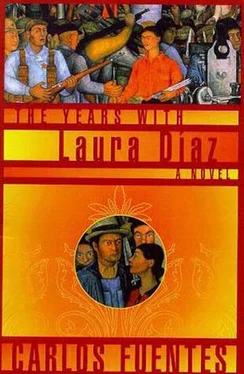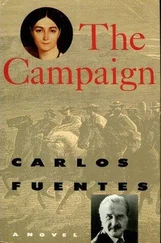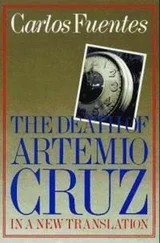“I’m staying here, Papa, if you don’t mind.”
“Not at all, my boy. This is your house. Don’t be silly.”
He had nothing to fear. Fernando Díaz’s private life was of an exemplary spotlessness. Concerning his past, it was well known that his first wife, Elisa Obregón, a descendant of immigrants from the Canary Islands, died giving birth to Santiago; that for the first seven years of the boy’s life, the now recently graduated poet lived under the protection — and thanks to the charity, almost — of a Jesuit priest from the city of Orizaba; that when Don Fernando remarried, he kept his new family far away in Catemaco but brought Santiago to live with him in Veracruz.
Asked to explain himself in one or another Veracruz gathering, this honorable if not very imaginative man of numbers said that sometimes it was necessary to defer satisfaction while doing one’s duty, which, ultimately, redoubled satisfaction.
These arguments, which seemed to convince people, merely provoked the scorn of Salvador Díaz Mirón: “I never would have suspected it, Don Fernando, but you are more baroque than the poet Góngora himself.”
But just as Don Fernando could not penetrate the mysteries of others, no one penetrated his — perhaps because they didn’t exist. Except for the perfect bride, his second wife, Leticia, who simply was equal to him. Yet the initial arrangement between the two of them was indeed baroque. For eleven years, Leticia, accompanied by her half sister, María de la O, would visit Fernando in Veracruz once a month, and he would take a room at the Hotel Diligencias so they could be alone while María de la O would discreetly disappear. (Only the grandmother, without fingers, Doña Cosima Kelsen, suspected where she went.) Every three months, in turn, Fernando would return to Catemaco, greet the German grandfather, and play with little Laura.
At the port, father and son lived in adjoining rooms in a boarding house, Santiago in the bedroom so he could study and write, Fernando in the living room, as if in free time between business appointments. Each one had his washbasin and his mirror for his personal grooming. The public bath was two streets away. A black woman with cloudlike hair took care of the chamber pots. They took their meals at the boardinghouse.
Now everything changed. The president’s residence above the bank had all the comforts — a big living room with a view of the docks, a wicker sofa because it was cooler, tables of varnished wood with marble tops, rockers, bibelots, electric lights as well as old candelabras, commodes with vitrines that displayed all sorts of Dresden figurines — licentious courtiers, daydreaming shepherdesses — and a pair of typical genre paintings. In the first, a little rascal teases a sleeping dog with a stick; in the second the dog bites the calf of a boy who can’t manage to jump over the wall and falls back bawling …
“Let sleeping dogs lie,” Mr. Díaz would invariably say in English whenever he looked, even out of the corner of his eye, at the paintings.
The dining room: with a table big enough to seat twelve and, once again, vitrines, these filled with china hand-decorated with scenes from the Napoleonic Wars, some of them edged with gold reliefs in the form of garlands.
A sort of antechamber or pantry, as Fernando called it, again in English: this connected the dining room and the kitchen redolent with herbs, stews, and tropical fruits that dripped with juice when cut in half, a kitchen of braziers and griddles, where the fire under the skillets and pots required untiring hands waving straw fans to keep it alive. Nothing satisfied Doña Leticia more than going from one brick-and-iron oven to the next, steadily fanning the embers to keep the broths, the rice, the sauces bubbling as she stirred them, while the Indian women from the Zongolica mountains made tortillas and the little black man Zampaya watered the flowerpots in the corridors, muttering a hymn to himself:
Black Zampayita’s dance,
you can see it in a glance,
will surely cure your every pain,
even help you weight to gain.
Sometimes, little Laura, with her head in her mother’s lap, would listen delightedly, for the thousandth time, to the story of how her parents met at the Candlemas festival in Tlacotalpan, a doll-house-sized village where on February 2 everyone, even the old-timers, would come at the sound of clarinets and guitars to dance on wooden floors in the plazas next to the Papaloapan River, along which passes the Virgin, from boat to boat, while all the neighbors bet on whether the Mother of God has the same hairdo as last year, hair that once belonged to Dulce María Estévez, or whether it was the hair given to her, at great sacrifice, by María Elena Muñoz. After all, every year the Virgin was supposed to have a fresh new hairdo, and it was a great honor for decent young ladies to sacrifice their hair to St. Mary.
Rows of men on horseback take off their hats when the Virgin passes, but the Veracruz widower Don Fernando Díaz, now thirty-three years old, has eyes only for the tall, slender, extremely refined Miss Leticia Kelsen (ask, and anyone will tell you), dressed in a stiff, white, parchmentlike fabric and barefoot, at the age of sixteen, not because she lacks shoes but because (as she explained to Fernando when he offered her his arm so she wouldn’t slip in the mud along the riverbank) in Tlacotalpan the greatest pleasure is to walk barefoot on grassy streets. Did he know any other city with grass growing in the streets? No, laughed Fernando, and he himself, to the glee and shock of the citizens of Tlacotalpan, took off his boots with complicated hooks and eyes and his red-and-white-striped socks that sent Miss Leticia into paroxysms of laughter.
“They look like clown socks!”
He blushed and blamed himself for having done something so alien to his regular, measured habits. She fell in love with him right on the spot, because he took off his shoes and turned as red as the stripes on his socks.
“What happened next, what happened next?” asked Laura, who knew the story by heart.
“No one can describe that town, you have to see it,” added her father.
“What’s it like, what’s it like?”
“Like a toy,” Doña Leticia went on. “All the houses are one story high, all even, but each one is painted a different color.”
“Blue, pink, green, red, orange, white, yellow, violet …” enumerated the child.
“The most beautiful walls in the world,” concluded her father, lighting up a cigar.
“A little toy village …”
Now that they had the big house in the port of Veracruz, the Kelsen sisters came to visit, and Don Fernando would tease them: Weren’t you three going to get married as soon as Leticia, Laura, and I got back together?
“And who would take care of María de la O?”
“They’ve always got an excuse,” laughed Don Fernando.
“That’s the absolute truth,” María de la O agreed with him. “I’ll stay and take care of my father. Hilda and Virginia can go and get married whenever they like.”
“I don’t need a husband,” exclaimed Virginia the writer, laughing … “Je suis la belle ténébreuse … I don’t need anyone to admire me.”
Hilda the pianist interrupted the laughing banter, putting an end to the subject with words no one understood: “Everything is hidden and lies in wait for us.”
Fernando glanced at Leticia, Leticia at Laura, and the girl copied the whitest aunt, moving her hands as if playing the piano, until Aunt Virginia gave her a sharp crack on the head and Laura held in her rage and her tears.
The visit of the aunts was an occasion to invite in specimens of Veracruz society. Once it happened that a group had gathered and Aunt María de la O came in late, and a lady said to her: “Girl, how good you’ve come. Fan me for a while, please. Don’t be a lazy darky now, it’s so hot …”
Читать дальше












